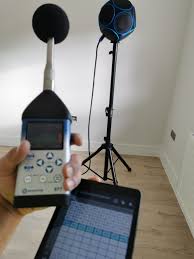Comprehensive Guide to Sound Testing in New Builds: Ensuring Quiet Living Spaces

Introduction to sound testing
Estimated read time 8-10 minutes
In the quest for peaceful living environments, sound testing in new builds plays a critical role.
This guide explores the intricacies of sound testing, ensuring compliance with regulations, and practical steps for enhancing acoustic performance in new properties.
Understanding Sound Testing and Building Regulations
Sound testing is essential for assessing the acoustic performance of walls and floors in new buildings.
Governed by Part E of the Building Regulations, this testing ensures that homes meet minimum standards for sound insulation
Sound Testing Methods
There are two primary methods: Impact Sound Testing, which measures noise transmission through floors using a tapping machine, and Airborne Sound Testing, which assesses sound through walls with speakers.
Compliance Standards Across the UK
In England, a minimum airborne sound reduction of 45dB and a maximum impact sound level of 62dB are required. Scotland’s standards are more stringent, with higher thresholds for compliance, demanding a score over 56dB.
Why Sound Testing is Crucial in New Builds
Adequate sound insulation is vital for comfort and legal compliance. Inadequate soundproofing can lead to disputes and even legal action, making compliance a priority for developers and homeowners alike.
The Sound Testing Process: Step-by-Step
Pre-Test Preparations:
All spaces should be cleared, and necessary equipment prepared.
On-Site Testing Procedures:
Conducted by certified professionals, these tests use specialized equipment to measure sound transmission.
Interpreting the Results:
A detailed report follows, indicating whether the building meets the required standards.
The pass/fail criteria depend on specific dB thresholds.
Common Misconceptions and Challenges
Many assume sound testing covers all noise issues within a property.
However, it primarily concerns noise between separate dwellings. Homeowners should be aware of the limitations and the importance of proper soundproofing in their homes.
Advances in Acoustic Technology and Soundproofing Solutions
Modern technologies have introduced advanced materials and methods for soundproofing.
From acoustic panels to innovative building techniques, there are numerous ways to enhance a home’s acoustic performance.
Frequently Asked Questions
What should I do if my property fails a sound test?
- Immediate steps should include consulting with a soundproofing expert to identify and rectify issues.
How often should sound testing be conducted?
- Typically, it’s a one-time requirement for new builds, but additional testing may be necessary after significant renovations.
Can sound testing be skipped if Robust Details are used?
- Yes, if the construction follows Robust Details, pre-approved designs, and methods, sound testing can sometimes be bypassed.
Conclusion and Next Steps
Sound testing is an integral part of ensuring a comfortable and compliant living space.
For homeowners and developers, understanding and adhering to these standards is crucial. For professional sound testing services, consult a UKAS-accredited company here or here.
ADDITIONAL INFORMATION
New Home Inspection:
Robust Details
Useful Links
UKAS Accredited Sound Testing Companies
